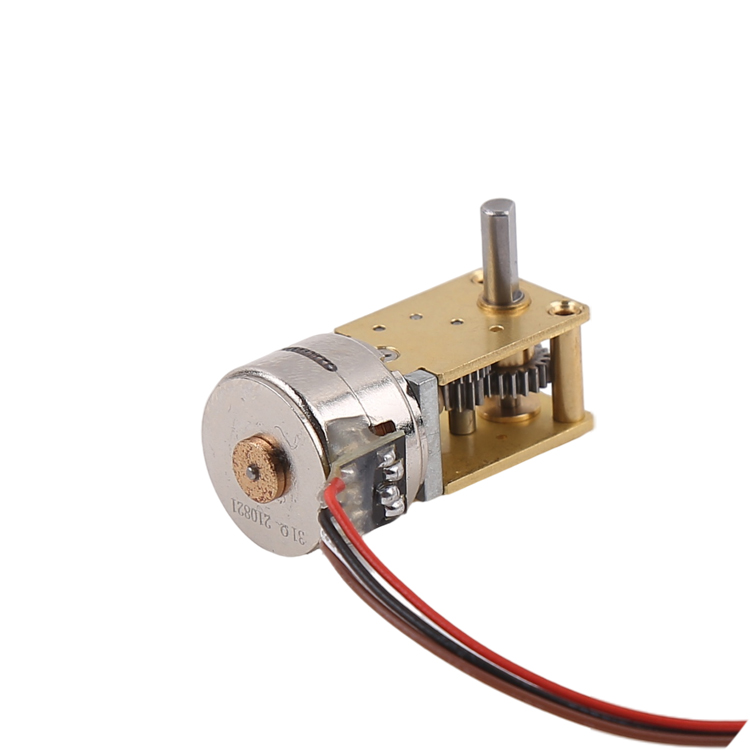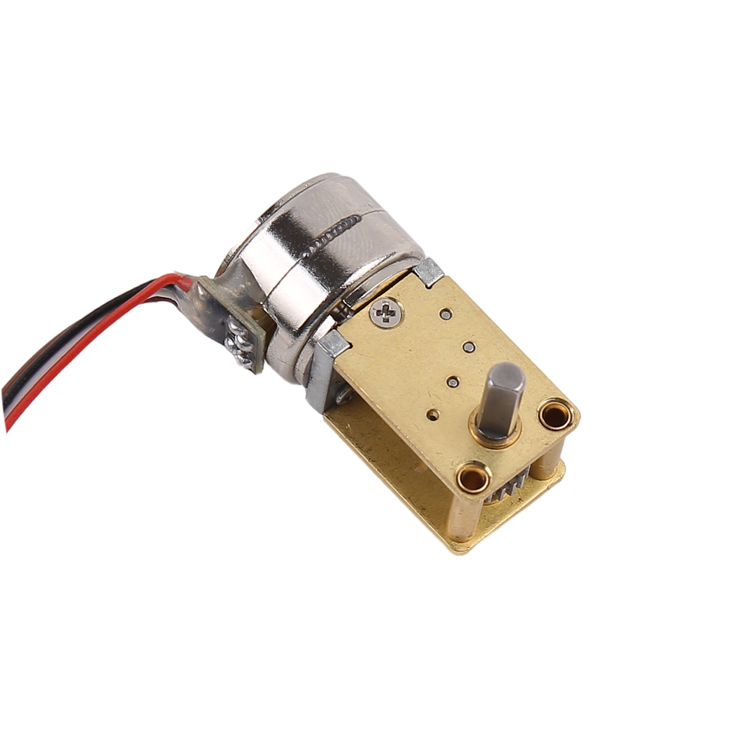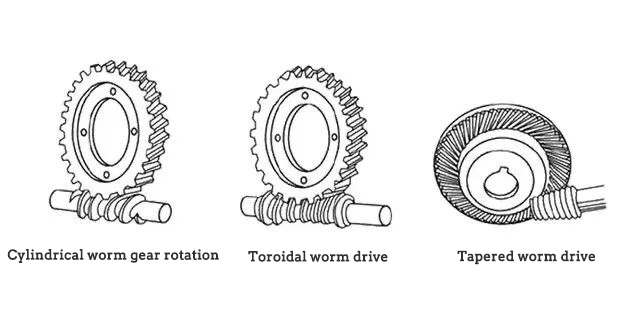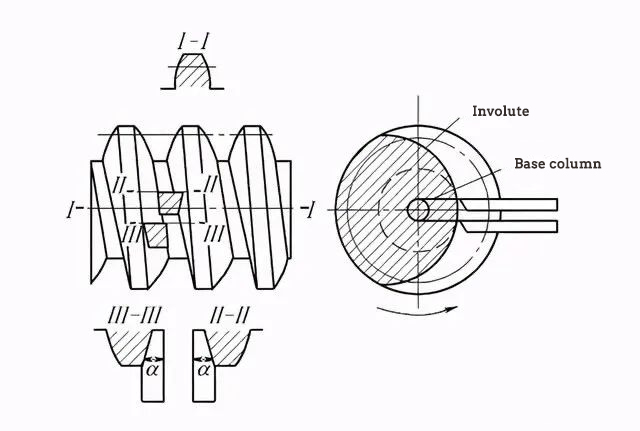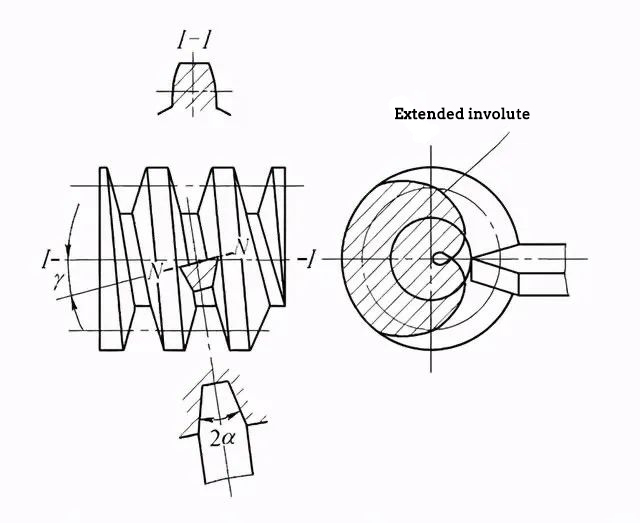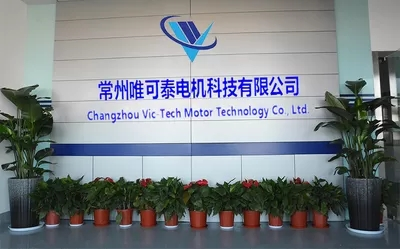قۇرت چىشلىق چاقنىڭ تارقىلىشى بىر قۇرت ۋە قۇرت چاقىدىن تەركىب تاپقان بولۇپ ، ئادەتتە قۇرت ئاكتىپ قىسىم. بۇ قۇرت جابدۇقلىرىنىڭ ئوڭ ۋە سول تەرەپتىكى يىپلىرى ئوخشاش بولۇپ ، ئايرىم-ئايرىم ھالدا ئوڭ ۋە سول قول قۇرت چىشلىرى دەپ ئاتىلىدۇ. بىر قۇرت بىر ياكى بىر نەچچە خىل چىشلىق چىشلىق چىشلىق چاق بولۇپ ، قۇرت چاقى بىلەن ماسلىشىپ ، كىشىنى ھەيران قالدۇرىدىغان ئوق چىشلىق جۈپ ھاسىل قىلىدۇ. كۆرسەتكۈچ يۈزى سىلىندىرلىق ، يۇمىلاق شەكىللىك ياكى يۇمىلاق شەكىللىك بولىدۇ ، ئارخىمېدېس قۇرتى ، چېتىشلىق قۇرت ، نورمال تۈز ئارخىپ قۇرت ۋە لېنتىغا ئورالغان سىلىندىرلىق قۇرتتىن ئىبارەت تۆت تۈر بار.
قۇرت چىشلىق چاق يەتكۈزۈشنىڭ ئەۋزەللىكى.
✦ يەككە باسقۇچلۇق يەتكۈزۈش نىسبىتى چوڭ ، ئادەتتە i = 10 ~ 100. توك يەتكۈزۈشنىڭ كۆرسەتكۈچ مېخانىزىمىدا ئەڭ يۇقىرى بولغاندا 1500 دىن ئېشىپ كېتىدۇ.
✦ ئوخشاش تورغا ئۇلاش سىزىقلىق ئالاقىلىشىش بولۇپ ، چوڭ قۇۋۋەتكە بەرداشلىق بېرەلەيدۇ.
✦ ئىخچام قۇرۇلما ، سىلىق يەتكۈزۈش ۋە تۆۋەن شاۋقۇن.
Wor قۇرتنىڭ كۆتۈرۈلۈش بۇلۇڭى چىشلىق چاق ئوتتۇرىسىدىكى تەڭ سۈركىلىش بۇلۇڭىدىن تۆۋەن بولغاندا ، ئۇ قارشى سوقۇلۇش ئارقىلىق ئۆزلۈكىدىن قۇلۇپلىنىدۇ ، يەنى پەقەت قۇرتلا قۇرت چاقىنى ئەمەس ، بەلكى قۇرت چاقىنى ھەيدىەلەيدۇ.
قۇرت چىشلىق چاقنىڭ كەمچىلىكى.
Two ئىككى ئوق بىلەن ئۇدۇل كېلىپ ، ئىككى چاق تۈگۈنىنىڭ سىزىقلىق تېزلىكى يانتۇ بولىدۇ ، شۇڭا نىسپىي سىيرىلىش سۈرئىتى چوڭ ، قىزىتىش ۋە كىيىش ئاسان.
Efficiency تۆۋەن ئۈنۈم ، ئادەتتە 0.7 دىن 0.8 گىچە. ئۆزلۈكىدىن قۇلۇپلانغان قۇرت چىشلىق چاق قۇرتلىرىنىڭ ئۈنۈمى تېخىمۇ تۆۋەن ، ئادەتتە 0.5 دىن تۆۋەن.
قىلقۇرت چىشلىق چاقلىق ماتورچوقۇم ئۆزىنى قۇلۇپلاش ئىقتىدارى بولۇشى كېرەكمۇ؟
ياق ، ئالدىنقى شەرت بار. قوغۇشۇن بۇلۇڭى <سۈركىلىش بۇلۇڭى ،قۇرت چىشلىق چاقلىق ماتورئۆزىنى قۇلۇپلىغىلى بولىدۇ.
ئادەتتە سۈرئەت ئۆزگەرتكۈچنى تۆۋەنلىتىش ماتورى تاللانغاندا ، ئىشلەتكۈچى چوقۇم توك كاشىلادىن مۇداپىئەلىنىش ياكى تورمۇز ماتورىنى ئىشلىتىشى كېرەك ، شۇڭا چىشلىق چاقنى ئازايتىش ماتورى تورمۇز بىلەن تاللىنىپ توختاپ قېلىش مەقسىتىگە يېتىدۇ ، ئەمما مۇتلەق توختاپ قېلىشتىن دېرەك بەرمەيدۇ ، ئازراق ئىنېرتسىيە يەنىلا بار.
ئۆزىنى قۇلۇپلاش دېگەن نېمە؟ئۆزىنى قۇلۇپلاش ئۇقۇمى شۇكى ، ھەر قانچە كۈچ قوزغىتالمىسىمۇ ، ھەر قانچە ئىنېرتسىيە بولۇشىدىن قەتئىينەزەر ، ئاكتىپ قىسىمنىڭ خىزمىتىنى توختىتىش ئۈچۈنلا ، پۈتكۈل ماشىنا تورمۇزلىيالايدۇ ، قۇرت چىشلىق چىشلىق چاقلىق ماتورنىڭ ئۆزلۈكىدىن قۇلۇپلاش ئىقتىدارى بار. چىشلىق چاق ماتورنىڭ ئۆزلۈكىدىن قۇلۇپلاش ئىقتىدارى يوق ، سۈرئەت نىسبىتى 1:30 ۋە ئۇنىڭدىن يۇقىرى بولغان قۇرت چىشلىق چاقنى ئازايتقۇچىلارنىڭ ئىشەنچلىك ئۆزلۈكىدىن قۇلۇپلاش ئىقتىدارى بار ، ئازايتىش نىسبىتى قانچە چوڭ بولسا ، ئۆز-ئۆزىنى قۇلۇپلاش ئىقتىدارى شۇنچە ياخشى بولىدۇ.
كېمەيتىش نىسبىتىنى قانداق تاللاش ئارقىلىق قۇرت چىشلىق چاقلىق ماتورنىڭ ئۆزلۈكىدىن قۇلۇپلىنىش ئىقتىدارىغا كاپالەتلىك قىلىش كېرەك؟
1 orm قۇرت چىشلىق سۈركىلىش كوئېففىتسېنتى 0.6 ، قۇرت چىشلىق چاقنىڭ يېتەكچى بۇلۇڭى ئۆزلۈكىدىن قۇلۇپلىنىدىغان ° C 3 ° 29′11 دىن تۆۋەن.
2 orm قۇرت چىشلىق سۈركىلىش كوئېففىتسېنتى 0.7 ، قۇرت چىشلىق چاقنىڭ يېتەكلەش بۇلۇڭى ئۆزلۈكىدىن قۇلۇپلىنىدىغان 4 ° 03′57 than دىن تۆۋەن ، ئەكسىچە.
3 wor قۇرت چاقىنىڭ سۈركىلىش كوئېففىتسېنتى 0.8 بولغاندا ، قۇرتنىڭ قوغۇشۇن بۇلۇڭى 4 ° 38′39 than دىن تۆۋەن بولىدۇ ، يەنى ئۆزلۈكىدىن قۇلۇپلىنىدۇ.
قۇرتنىڭ قوغۇشۇن بۇلۇڭى چىشلىق چاقنىڭ چىشى بىلەن باراۋەر سۈركىلىش بۇلۇڭىدىن تۆۋەن بولغاندا ، كېمىيىش باسقۇچى ماتورلۇق مېخانىزىمىنىڭ ئۆزلۈكىدىن قۇلۇپلىنىشى بولىدۇ ، ئۇ تەتۈر ئۆزلۈكىدىن قۇلۇپلىنىشنى ئەمەلگە ئاشۇرالايدۇ ، يەنى پەقەت قۇرتلا قۇرت چاقىنى قوزغىتالايدۇ ، ئەمما قۇرت چاقى قۇرتنى ھەيدىمەيدۇ. ئادەتتە ئېغىر ماشىنىلارنى لايىھىلەشتە ، لايىھىلىگۈچىلەر ئۆزلۈكىدىن قۇلۇپلاش ئارقىلىق قۇرت چىشلىق مېخانىزىمىنى ئىشلىتىشكە مايىل ، چۈنكى ئۇنىڭ تەتۈر ئۆزلۈكىدىن قۇلۇپلىنىشى بىخەتەرلىك قوغداشتا ئىنتايىن مۇھىم رول ئوينايدۇ.
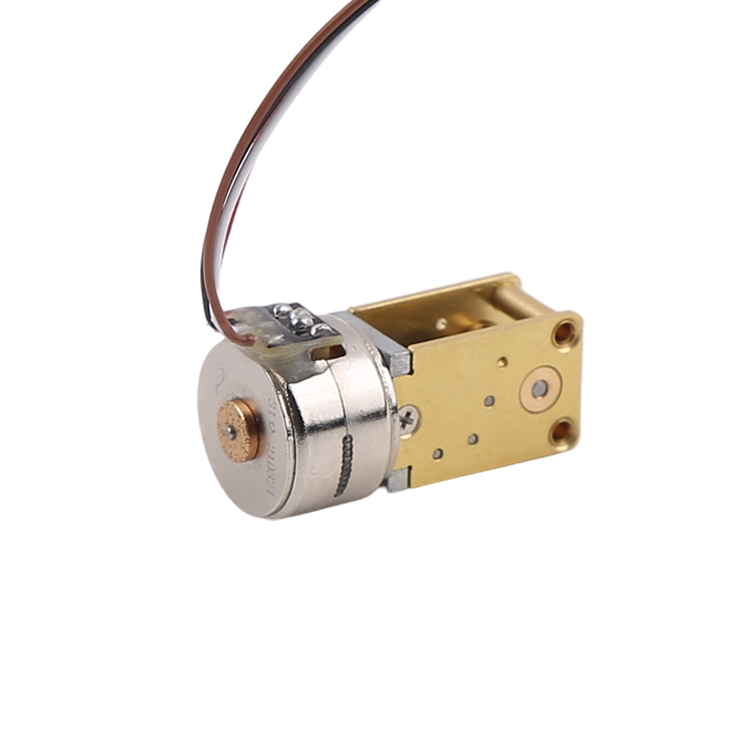
قۇرت چاقى ۋە قۇرت جابدۇقلىرىنىڭ ھېسابلاش فورمۇلاسى.
1. تارقىلىش نىسبىتى = قۇرت چىشلىق چىش سانى wor قۇرت بېشىنىڭ سانى
2 、 مەركىزى ئارىلىق = (قۇرت چاق مەيدانى + قۇرت چىشلىق چاق) ÷ 2
3 orm قۇرت چاقىنىڭ دىئامېتىرى = (چىش سانى + 2) × مودۇل
4 orm قۇرت چاقى مەيدانى = مودۇل چىش سانى
5 orm قۇرت مەيدانى = قۇرتنىڭ سىرتقى دىئامېتىرى -2 × مودۇل
6 orm قۇرت يېتەكچىسى = π × مودۇل × باش
7 、 Helix بۇلۇڭى (يېتەكچى بۇلۇڭ) tgB = (مودۇل × باش نومۇرى) ÷ قۇرت مەيدانى
8 orm قۇرت قوغۇشۇن = π × مودۇل × باش
9 、 Modulus = كۆرسەتكۈچ چەمبىرىكىنىڭ دىئامېتىرى / چىش سانى
قۇرت بېشىنىڭ سانى: يەككە باشلىق قۇرت (قۇرتتا پەقەت بىرلا خىلىت بار ، يەنى قۇرت بىر ھەپتە ئايلىنىدۇ ، قۇرت چاقى بىر چىشتىن ئايلىنىدۇ); قوش باشلىق قۇرت (قۇرتنىڭ ئۈستىدە ئىككى خىل قاپارتما بار ، يەنى قۇرت بىر ھەپتە ئايلىنىدۇ ، قۇرت چاقى ئىككى چىشتىن ئايلىنىدۇ).
مودۇل بولسا نەيچىدىكى خېلىكسنىڭ چوڭ-كىچىكلىكى ، يەنى مودۇل قانچە چوڭ بولسا ، بۇرمىلاش ئېغىزى شۇنچە چوڭ بولىدۇ.
دىئامېتىرى ئامىلى نەيچىنىڭ قېلىنلىقى.
مودۇل: چىشلىق چاقنىڭ كۆرسەتكۈچ چەمبىرىكى چىشلىق چاقنىڭ ھەر بىر قىسمىنىڭ چوڭ-كىچىكلىكىنى لايىھىلەش ۋە ھېسابلاشنىڭ ئۆلچىمى ، شۇنداقلا چىشلىق چاق چەمبىرىكىنىڭ ئايلانمىسى = πd = zp ، شۇڭا كۆرسەتكۈچ چەمبىرىكىنىڭ دىئامېتىرى
d = zp / π
Π يۇقارقى تەڭلىمىلەردىكى ئەقىلگە سىغمايدىغان سان بولغاچقا ، كۆرسەتكۈچ چەمبىرىكىنىڭ پايدىلىنىش ئورنى ئورنىتىشىغا قۇلايلىق ئەمەس. ھېسابلاش ، ياساش ۋە تەكشۈرۈشكە قۇلايلىق يارىتىش ئۈچۈن ، p / نىسبىتى ھازىر سۈنئىي ئۇسۇلدا بىر قىسىم ئاددىي قىممەتلەر سۈپىتىدە بېكىتىلدى ، بۇ نىسبەت مودۇل (مودۇل) دەپ ئاتىلىدۇ ، m دەپ ئىپادىلىنىدۇ.
قۇرت جابدۇقلىرىنىڭ تۈرلىرى
قۇرتنىڭ ئوخشىمىغان شەكىللىرىگە ئاساسەن ، قۇرتنى سىلىندىرسىمان قۇرت ھەيدەش ، يىللىق قۇرت ھەيدەش ۋە قوڭۇر قۇرت ھەيدەشكە بۆلۈشكە بولىدۇ. بۇنىڭ ئىچىدە سىلىندىرلىق قۇرت قوزغاتقۇچ ئەڭ كۆپ ئىشلىتىلىدۇ.
ئادەتتىكى سىلىندىرلىق قۇرت چىشلىرى كۆپىنچە تۈز ئاپتوبۇس تىغ بىلەن بۇرۇلۇش قورالى بىلەن رېشاتكىغا كېسىلىدۇ. قورال ئورنىتىش ئورنى ۋە ئىشلىتىلگەن قورالنىڭ ئوخشىماسلىقىغا ئاساسەن ، تىك ئوقنىڭ كېسىشمە بۆلىكىدە ئوخشىمىغان چىش ئارخىپى بار تۆت خىل قۇرت چىشلىق چاققا ئېرىشكىلى بولىدۇ: چېتىشلىق قۇرت چىشلىق چاق (ZI تىپى) ، Archimedes قۇرت چىشلىق چاق (ZA تىپى) ، نورمال تۈز ئارخىپ قۇرت چىشلىق چاق (ZK).
قۇرتقا چېتىش (ZI تىپى)- تىغلىق ئايروپىلان قۇرت ئاساسى سىلىندىرغا ماس كېلىدۇ ، ئاخىرقى چىشلار چېتىلىدۇ ، تېخىمۇ تېز ۋە تېخىمۇ چوڭ قۇۋۋەتكە ماس كېلىدۇ.
Archimedean قۇرتى (ZA تىپى)- ئوق تەكشىلىكىگە ئۇدۇل كەلگەن چىش ئارخىپى Archimedean بۇرمىسى بولۇپ ، ئايروپىلاننىڭ ئوقتىن ئۆتكەن چىش ئارخىپى تۈز ، ئاددىي پىششىقلاپ ئىشلەش ۋە توغرىلىقى تۆۋەن. (Axial تۈز ئارخىپ قۇرت جابدۇقلىرى).
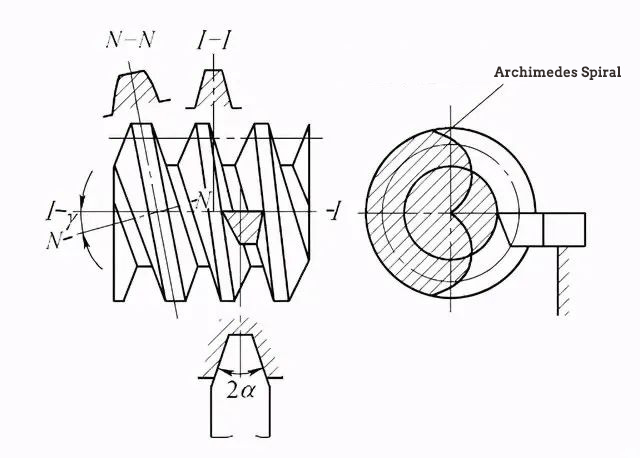
نورمال تۈز ئارخىپ قۇرتى (ZN)- ئۆزگەرتىلگەن ئۇششاق چاق بىلەن چىشنى ئۇۋىلاشقا ئىشلىتىشكە بولىدۇ ، پىششىقلاش ئاددىي ، كۆپىنچە كۆپ باشلىق قۇرتقا ئىشلىتىلىدۇ ، يەتكۈزۈش ئۈنۈمى 0.9 گە يېتىدۇ.
يەتكۈزۈشنى قىسقىچە چۈشىنىدىغانلىقىڭىزنى كۆرۈپپرىنسىپىقۇرت چىشلىق ماتورئەگەر ئالاقىلىشىشنى خالايدىغان باشقا نەرسە بولسابىز بىلەن ئالاقىلىشىڭ!
بىز خېرىدارلار بىلەن يېقىندىن پىكىر ئالماشتۇرىمىز ، ئۇلارنىڭ ئېھتىياجىنى ئاڭلايمىز ۋە ئۇلارنىڭ تەلىپىگە ئاساسەن ئىش قىلىمىز. ئىشىنىمىزكى ، ئورتاق پايدا ئالىدىغان ھەمكارلىقنىڭ ئاساسى مەھسۇلات سۈپىتى ۋە خېرىدارلار مۇلازىمىتى.
چاڭجۇ ۋېك تېخنىكا ماتورلۇق تېخنىكا چەكلىك شىركىتى ماتورلۇق تەتقىقات ۋە تەرەققىيات ، ماتورلۇق قوللىنىشچان پروگراممىلارنى ئومۇميۈزلۈك ھەل قىلىش ۋە ماتورلۇق مەھسۇلاتلارنى پىششىقلاپ ئىشلەش ۋە ئىشلەپچىقىرىشنى ئاساس قىلغان كەسپىي تەتقىقات ۋە ئىشلەپچىقىرىش تەشكىلاتى. چەكلىك مەسئۇلىيەت شىركىتى 2011-يىلدىن باشلاپ مىكرو ماتور ۋە قوشۇمچە زاپچاسلارنى ئىشلەپچىقىرىش بىلەن شۇغۇللانغان.
گۇرۇپپىمىزنىڭ مىكرو ماتور لايىھىلەش ، ئېچىش ۋە ياساشتا 20 نەچچە يىللىق تەجرىبىسى بار ، ئالاھىدە ئېھتىياجغا ئاساسەن مەھسۇلاتلارنى تەرەققىي قىلدۇرالايدۇ ۋە لايىھىلەش خېرىدارلىرىغا ياردەم بېرەلەيدۇ! ھازىر بىز ئاساسلىقى ئاسىيا ، شىمالىي ئامېرىكا ۋە ياۋروپادىكى ئامېرىكا ، ئەنگىلىيە ، كورېيە ، گېرمانىيە ، كانادا ، ئىسپانىيە قاتارلىق نەچچە يۈز دۆلەتتىكى خېرىدارلارغا ساتىمىز ، بىزنىڭ «سەمىمىيەت ۋە ئىشەنچلىك ، سۈپەتكە يۈزلەنگەن» سودا پەلسەپىسى ، «خېرىدار بىرىنچى» قىممەت ئۆلچىمىمىز ئىقتىدارنى ئاساس قىلغان يېڭىلىق يارىتىش ، ھەمكارلىق ، كارخانىنىڭ ئۈنۈملۈك روھىنى تەشەببۇس قىلىپ ، «قۇرۇش ۋە ئورتاقلىشىش» نى بەرپا قىلىش ئاخىرقى مەقسەت خېرىدارلىرىمىز ئۈچۈن ئەڭ يۇقىرى قىممەت يارىتىش.
يوللانغان ۋاقتى: 1-ئاينىڭ 30-كۈنىدىن 20-كۈنىگىچە

